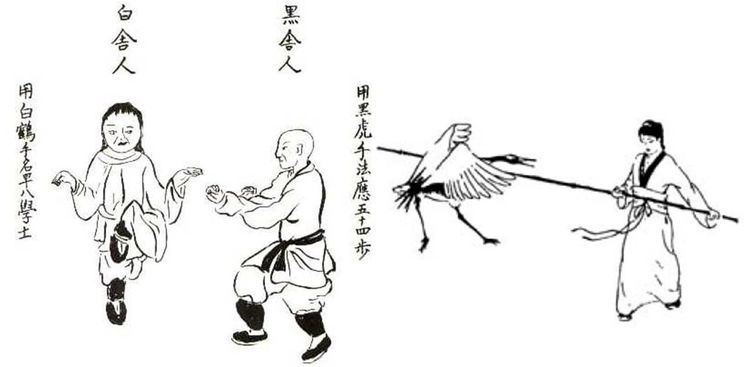Also known as Pe̍h-ho̍h-kûn Country of origin China | Focus Striking Parenthood Ming-era Nanquan | |
 | ||
Creator Fāng Qīnián (tradition) Famous practitioners Lǐ WénmàoChen ZuozhenHuang Laoyang | ||
White Crane Style (in Chinese: 白鶴拳) is a Southern Chinese martial art that originated in Fujian (福建) province. According to oral tradition, the style was developed by Fang Qīniáng (方七娘; Amoy Min Nan: Hng Chhit-niâ), a female martial artist. It is associated with traditional fighting techniques, including long range, but is most similar to close-quarter or hand-to-hand combat. It is most recognizable by the way the fighter imitates a bird's pecking or flapping of wings. While some white crane styles make use of traditional weapons, others have discontinued the use of weaponry.
Contents
- The legend of the white crane
- Branches
- History
- Feeding Crane in Taiwan
- Calling Crane in China
- DancingShaking Crane in Taiwan
- Influence
- References
Fujian White Crane is a type of Shaolin Boxing that imitates characteristics of the Taiwanese Crane. An entire system of fighting was developed from observing the crane's movements, methods of attack and spirit. It is one of the six well-known schools of Shaolin Boxing. The others are based on Tiger, Monkey, Leopard, Snake and Dragon. Additional, lesser-known schools include Dog, Deer and Bear.
The legend of the white crane
Qīniáng and her father lived in Fujian province, where many cranes live. Qīniáng's father knew the Southern Chinese Martial Arts and taught them to his daughter. One day, while Qīniáng was doing her chores, a crane landed nearby. Qīniáng tried to scare the bird off using a stick and the skills she had learned from her father, but whatever she did, the crane would counter. Qīniáng tried to hit the crane on the head, but the bird moved its head out of the way and blocked the stick with its wings. Qīniáng tried to hit the crane's wings, but the crane stepped to the side and blocked the stick with its claws. Qīniáng tried to poke the crane's body, but the crane dodged backwards and struck the stick with its beak. From then on, Qīniáng carefully studied the crane's movements. She combined these movements with techniques learned from her father, ultimately creating the White Crane Style of Fujian province.
There are many versions of this legend. In some the crane does not block a stick, but evades and counters it. The point of the style is to emphasize evasion and attack an opponent's vulnerabilities instead of using physical strength. Since it was created by a woman, White Crane fighting elements are especially popular in women's self-defense training because the movements do not require great strength. They more closely imitate the delicate pecking motion associated with this fighting style. Popular karate bunkai (breakdown) of white crane katas like hakutsuru stress vital point striking or kyusho.
Branches
Over time, White Crane branched off into 5 styles:
History
According to the traditions of the Lee family branch of Flying Crane, Fāng Qīniáng was born in the mid-18th century.
According to this tradition, the Ong Gong Shr Wushuguan was established in the town of Yongchun (永春; Minnan: eng2 chhun1), prefecture of Quanzhou, Fujian province, when its founders were taught by Fang Qiniang during the reign of the Jiajing Emperor (r. 1521–66) of the Ming dynasty.
Pingyang White Crane was created by Fāng Qī Niáng during Shunzhi period during the Qing dynasty. During Jiaqing period, this kongfu spread to Pingyang city.
Yongchun-style White Crane was created by Fāng Qī Niáng during KangXi period during the Qing dynasty. Yongchun combined the movements of White Crane with Shaolin kongfu. The film Yongchun White Crane describes the history and development of this Kongfu.
Li Wenmao (李文茂), an opera performer and leader of the 1854–1856 Red Turban Rebellion in Foshan, is said to have practiced the Yǒngchūn style of White Crane.
The Xu-Xi Dao style of White Crane as taught by Chen Zhuozhen was derived from Zhong-Ho 'Springing Crane' and was developed in Taiwan by Huang Laoyang in the 1950s.
Feeding Crane in Taiwan
The lineage of Feeding Crane in Taiwan is:
Calling Crane in China
Dancing/Shaking Crane in Taiwan
Influence
Fujian White Crane is one of the constituent styles of Five Ancestors.
Five Ancestors as well as various styles of Karate, notably Goju-ryu, Chitō-ryū and Uechi-ryu use the routine "San Chian" from Fujian White Crane. San Chian is best known by the Japanese pronunciation of its name, Sanchin.
